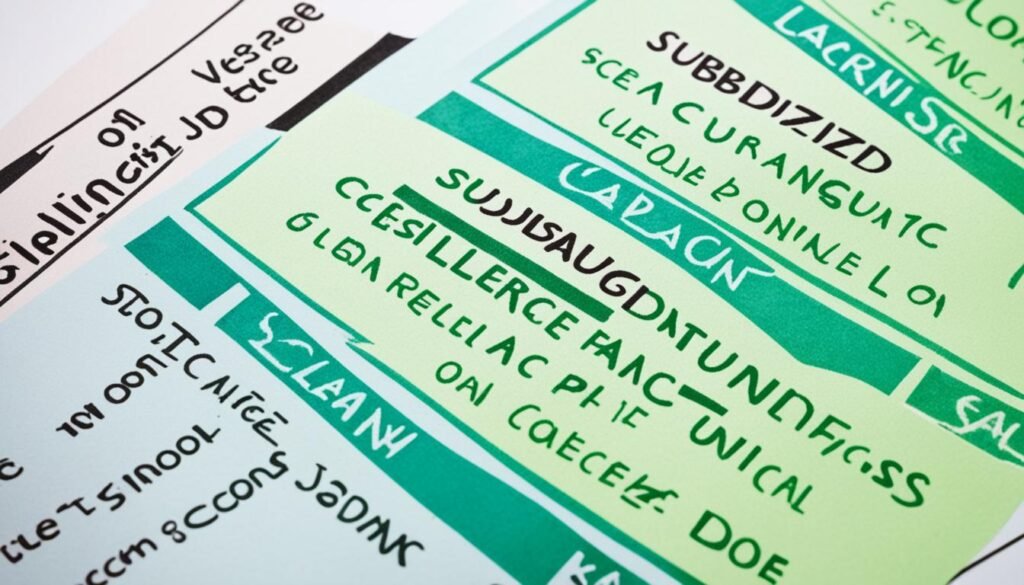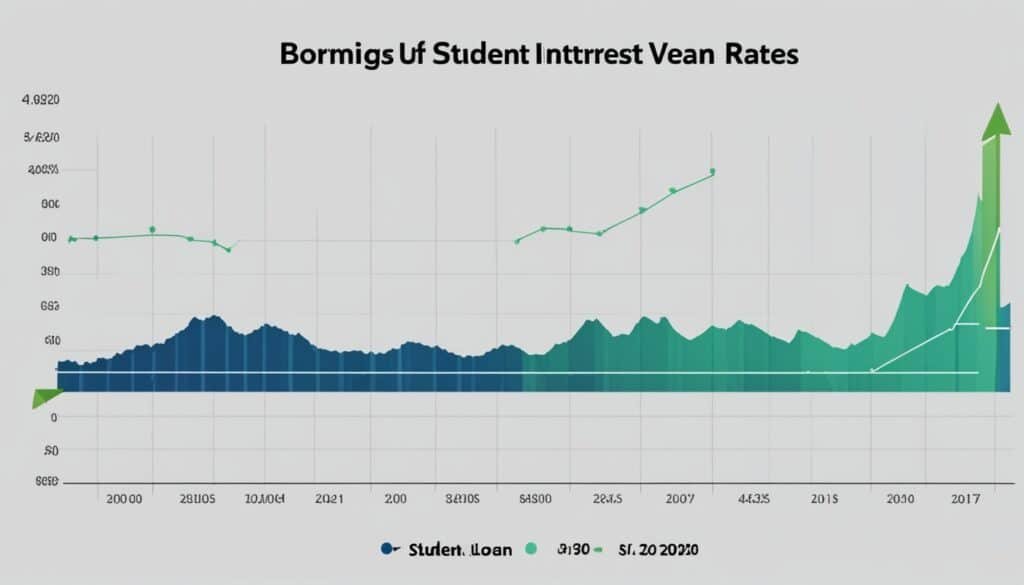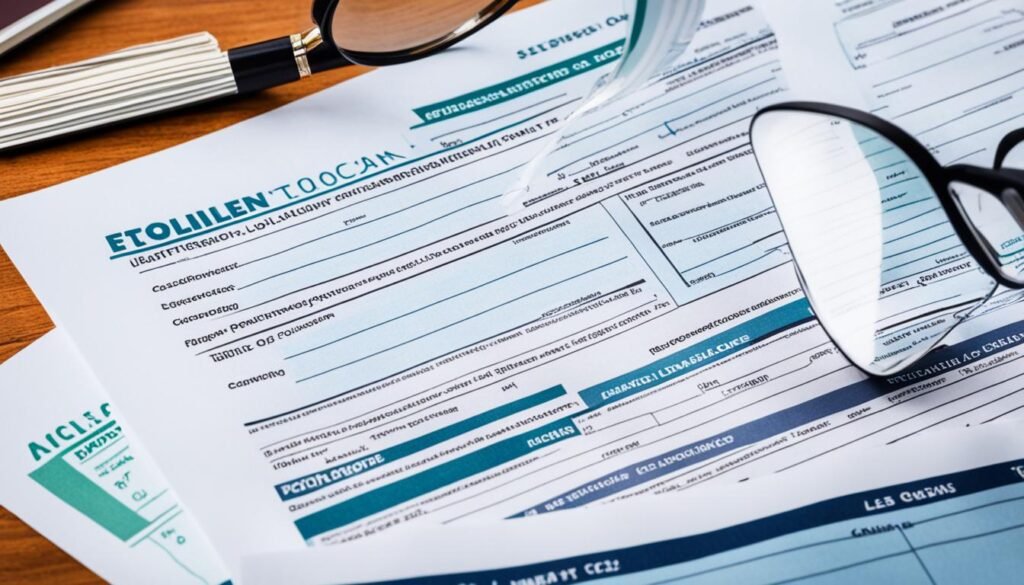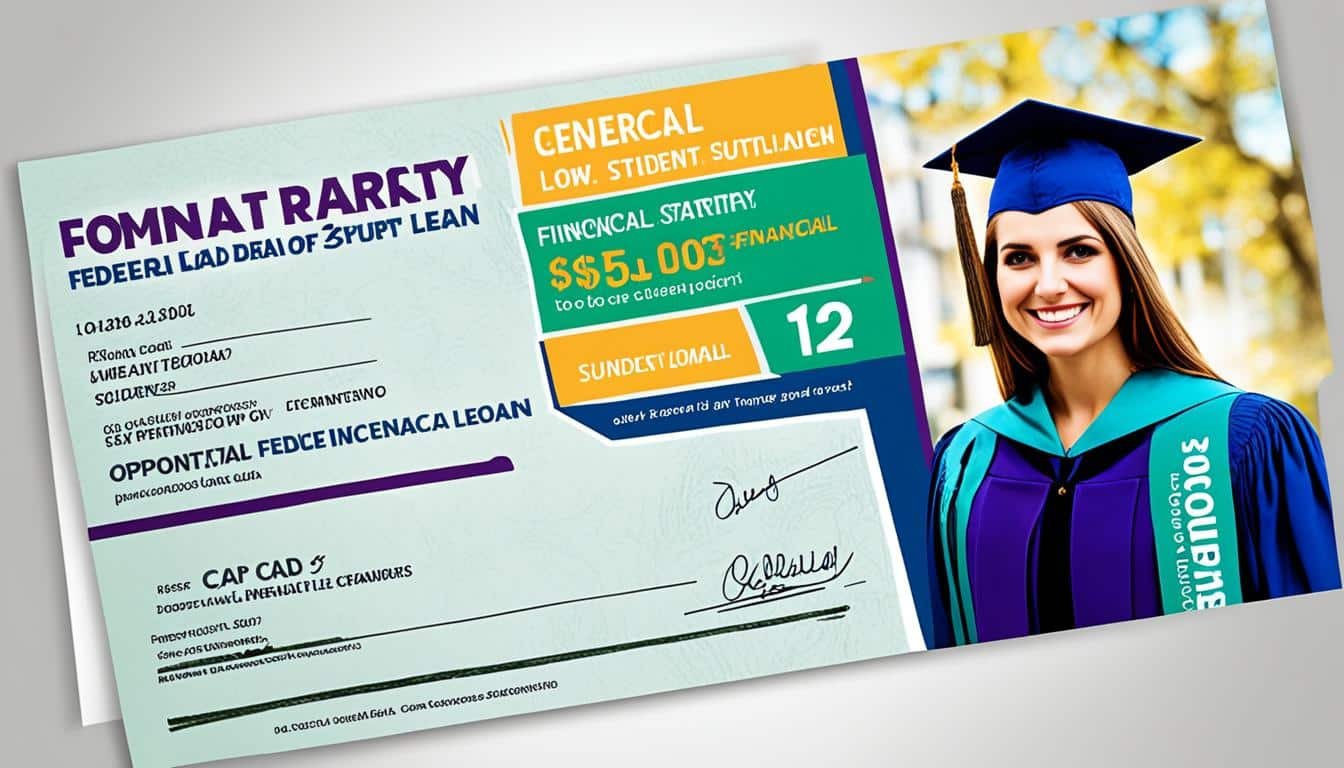What Loans Are Available For College Students: Getting a college degree is a big financial step, but there are many loans to help. Some loans come from the government, while others are from private places. It’s key to know which loans you can get and what rules they follow to make smart choices about paying for college.
Key Takeaways
- Federal student loans, including Direct Subsidized, Direct Unsubsidized, and Direct PLUS Loans, offer competitive interest rates and flexible repayment options.
- Subsidized loans are available based on financial need, while unsubsidized loans are open to all eligible students regardless of need.
- The FAFSA, or Free Application for Federal Student Aid, is the gateway to accessing federal financial aid, including grants, work-study, and loans.
- Private student loans can supplement federal aid, but may have less favorable terms and lack the same protections as government-backed loans.
- Responsible borrowing practices, such as only taking out what is needed, can help manage student loan debt after graduation.
Types of Federal Student Loans
Federal student loans are a top choice for college financing. The U.S. government provides them, aiming to make college more affordable. Let’s look into the kinds of federal student loans out there.
Direct Subsidized Loans
Direct Subsidized Loans are given to those in financial need. They stand out because the government pays the interest while you’re in school. This feature helps cut down the loan’s total cost, which is great for students on tight budgets.
Direct Unsubsidized Loans
Direct Unsubsidized Loans don’t require you to show financial need. You are responsible for the interest, even when in school. This could lead to a larger loan amount over time. But, it’s a good option for those not eligible for need-based aid.
Direct PLUS Loans
Parents of undergrads and graduate students can get Direct PLUS Loans. These loans have higher interest rates and need a credit check. They’re useful for families needing more financial help than what’s offered by other federal loans.
Direct Consolidation Loans
Direct Consolidation Loans help combine multiple loans into one. They come with a fixed interest rate. This can make paying back the loans simpler and may reduce how much you pay each month. It’s a way to make student debt easier to handle.
Knowing the various federal loan types is essential for college planning. By learning about these options, students and families can better choose what’s best for their financial and educational future.
| Loan Type | Interest Paid By | Credit Check Required | Eligibility |
|---|---|---|---|
| Direct Subsidized Loans | Federal government while in school, grace period, and deferment | No | Undergraduate students with demonstrated financial need |
| Direct Unsubsidized Loans | Borrower | No | Undergraduate and graduate students |
| Direct PLUS Loans | Borrower | Yes | Parents of dependent undergraduate students and graduate/professional students |
| Direct Consolidation Loans | Borrower | No | Borrowers with multiple federal student loans |
Understanding Subsidized vs. Unsubsidized Loans

There are two kinds of federal student loans: subsidized and unsubsidized. The big difference is who pays the interest while the student is in school.
Subsidized loans are great for those who need help. The government covers the interest until you finish school or go less than half-time. On the other hand, unsubsidized loans start gathering interest as soon as you get the money. It doesn’t matter if you really need the help or not.
Interest rates are the same for both types. But because unsubsidized loans keep gathering interest, you might end up owing more. Subsidized loans are given to students with financial need. Anyone can get an unsubsidized loan, even if you don’t need it.
| Feature | Subsidized Loans | Unsubsidized Loans |
|---|---|---|
| Interest Accrual | Government pays interest while in school | Borrower responsible for interest from disbursement |
| Eligibility | Based on financial need | Available regardless of need |
| Interest Rates | Same fixed rates as unsubsidized loans | Same fixed rates as subsidized loans |
| Repayment | May result in lower overall debt | May result in higher overall debt |
It’s key to know the difference between subsidized and unsubsidized student loans. This helps you pick the best choice for your financial needs and repayment plans.
What Loans Are Available For College Students

Students have many loan options when paying for college. They can get federal student loans or loans from private lenders. It’s important to know the difference to make smart financial choices.
Federal student loans like Direct Subsidized and Unsubsidized Loans are the best first choice. They come with a fixed interest rate, and you can pick from several ways to repay. If you’re eligible, your loan might even forgive part of the debt.
If you take a Direct Subsidized Loan, the government might pay the interest while you’re in school. This makes these federal loans more affordable.
Private student loans usually have higher interest rates than federal ones. Plus, they’re less likely to have flexible payment options. You can’t benefit from federal help like reduced repayment plans or loan forgiveness.
So, it’s best to use up all your federal loan options first. Private loans should only be considered if you’ve looked at everything else. They are seen as the last choice because they could cost you more in the long run.
| Loan Type | Interest Rates | Repayment Options | Eligibility |
|---|---|---|---|
| Federal Loans | Fixed, lower rates | Flexible, with potential for forgiveness | Based on financial need |
| Private Loans | Variable, higher rates | Less flexible, no forgiveness options | Based on creditworthiness |
As you look at how to pay for college, think about the good and bad of each loan type. By knowing the types of student loans out there, you can avoid big money problems later. This way, you can pick what’s best for your education without too much worry about money.
“Exhaust your federal loan options before turning to private loans, which should be a last resort.”
Loan Interest Rates and Borrowing Limits

When looking for ways to pay for college, it’s important to know your loan options. This includes understanding the interest rates and how much you can borrow. Federal student loans, like Perkins Loans, and Direct Subsidized and Unsubsidized Loans, have rates that don’t change. They are decided by the government once a year.
Perkins Loans
Perkins Loans are for students in great financial need. For the academic year of 2022-2023, they have a 5.5% interest rate. These loans come directly from the student’s school.
Direct Subsidized Loans
Direct Subsidized Loans help undergraduates who need financial aid. They have the same 5.5% interest rate for 2022-2023. The good thing is that the government covers the loan interest while you’re in school and even after you graduate for a while.
Direct Unsubsidized Loans
Direct Unsubsidized Loans are also available for students. They have a 5.5% interest rate this year. But, unlike the Subsidized Loans, the interest starts adding up right away.
Federal loans come with limits on how much you can borrow every year. These limits change depending on the loan type and if you’re a first-year or other types of students. For first-year students, the combined limit for Subsidized and Unsubsidized Loans is $5,500 per year.
| Loan Type | Interest Rate (2022-2023) | Annual Borrowing Limit |
|---|---|---|
| Perkins Loans | 5.5% | Varies by school |
| Direct Subsidized Loans | 5.5% | $3,500 – $5,500 |
| Direct Unsubsidized Loans | 5.5% | $5,500 – $12,500 |
It’s key to know about the interest rates and how much you can borrow with these federal loans. This helps you make smart choices about college funding. By being informed, you can use the loans wisely and make the most of your financial aid.
Parent PLUS and Private Student Loans

Parents looking for ways to pay for their child’s education have options beyond federal loans. They can consider PLUS loans and private student loans.
PLUS Loans: A Parent-Driven Solution
PLUS loans, or Parent Loans for Undergraduate Students, help parents pay for their child’s education. Being a credit-based loan, they check the parent’s credit. This means a higher interest rate at 8.05% for the 2022-2023 school year. When taking on this debt, parents should think about their financial state.
Private Student Loans: An Alternative Financing Option
If students have already used up their federal loans, they can look to private student loans. These are offered by banks, credit unions, and other lenders. They carry higher interest rates and not-so-great terms. It’s wise for students to exhaust federal loan options first.
| Loan Type | Interest Rate (2022-2023) | Borrowing Limit |
|---|---|---|
| PLUS Loans | 8.05% | Cost of attendance minus other financial aid |
| Private Student Loans | Varies by lender, typically higher than federal loans | Varies by lender, may be higher than federal loan limits |
When seeking alternative financing, it’s key to look at loan terms, interest rates, and how you’ll pay the money back. This helps everyone make choices that fit their financial goals.
“Exhaust all federal loan options before turning to private student loans, which typically have higher interest rates and less favorable terms.”
Responsible Borrowing Practices

Getting student loans can be daunting for college students. It’s important to borrow wisely. While it may be tempting to take more, it’s not smart. In fact, borrowing extra for stuff you don’t need can spike your debt and interest costs.
Therefore, think hard about your real expenses. Only borrow what’s truly necessary for tuition, housing, and other vital needs. This, combined with solid financial know-how and careful borrowing, will lighten your debt load later.
Only Borrow What You Need
To manage student loan debt, borrow only for essential education costs. First, look closely at what you need. Then, make a budget that covers tuition, books, and more. By keeping your borrowing to a minimum, you’ll lower both your debt and interest in the long run.
- Carefully review your college costs and create a detailed budget
- Borrow only the amount necessary to cover essential educational expenses
- Avoid taking out additional loans for non-essential items or activities
- Prioritize financial literacy to make informed borrowing decisions
Good borrowing habits are key to a brighter financial future. With less debt and a solid financial stance, reaching your dreams is more possible. So, practice debt reduction and financial responsibility for a better tomorrow.
Loan Consolidation Options

For students with several federal student loans, the idea of student loan consolidation is a big deal. It means rolling everything into one Direct Consolidation Loan. With this, you get a fixed interest rate. This makes things simpler to pay back and could cut your monthly cost. Yet, there are some things you must know.
One big win with federal loan consolidation is making repayment easier. You pull all your loans together, so there’s only one payment to watch. This could help you stay organized. Plus, you might see a lower interest rate thanks to the mix of your previous loans and current rates.
But, nothing is all good. Choosing student loan consolidation could mean stretching out how long you’ll pay. This could rack up more interest over time. So, think hard about what’s best for your money and future before jumping in.
Getting a federal loan consolidation isn’t too hard if you qualify. It’s free to apply, and you can start after finishing school or changing to part-time studies. Know what consolidating means for you. This way, you can make smart money moves to reach your financial dreams.
“Consolidating your federal student loans can simplify repayment and potentially lower your monthly payments, but it’s important to weigh the pros and cons carefully.”
Also Read : Asset-Based Loans: Leveraging Your Assets for Business Growth
Conclusion
College financing is hard, but students can find help. They can use federal student loans like Direct Subsidized, Direct Unsubsidized, and Direct PLUS. These loans have low rates and easy terms, which many students like. There are also private loans and parent PLUS loans for more money.
Knowing about each loan is key. Students should compare things like rates, how much you can borrow, and how you pay the money back. Looking into scholarships and grants is also smart. This way, students can avoid too much debt and be more secure after college.
Choosing how to pay for college is a big deal. Students need to think hard about what works best for them. Good planning means they can use loans wisely and achieve their education goals.
FAQs
What types of federal student loans are available?
There are four main types of federal student loans. These include Direct Subsidized Loans and Direct Unsubsidized Loans. Also, there are Direct PLUS Loans and Direct Consolidation Loans.
What is the key difference between subsidized and unsubsidized federal student loans?
The main difference is in who pays the loan’s interest while in school. For subsidized loans, the government pays the interest. For unsubsidized loans, you must pay the interest from the start.
What types of loans are available for college students besides federal student loans?
Along with federal loans, students can get private loans from banks and credit unions. Other lenders might offer them too.
What are the current interest rates and borrowing limits for federal student loans?
For the 2022-2023 school year, Perkins Loans, Subsidized, and Unsubsidized Loans have a 5.5% interest rate. Loan limits depend on the loan type and your school year.
What are PLUS Loans and how do they differ from other federal student loans?
PLUS Loans are for parents and grad students. They have a higher interest rate (8.05% for 2022-2023). PLUS Loans need a credit check, unlike other federal loans.
What are some best practices for responsible student loan borrowing?
It’s best to borrow only what you need for school costs. Keep up with your financial smarts. This can help you borrow wisely. It might lower your debt after school.
How can students consolidate their federal student loans?
With a Direct Consolidation Loan, you can merge your multiple federal loans into one. This loan has a fixed interest rate. It can make it easier to pay back and you might save money each month.
Source Links
- https://www.salliemae.com/college-planning/student-loans-and-borrowing/
- https://bigfuture.collegeboard.org/pay-for-college/get-help-paying-for-college/college-loans/quick-guide-which-college-loans-are-best
- https://www.usnews.com/education/best-colleges/paying-for-college/articles/understanding-federal-student-loan-types






